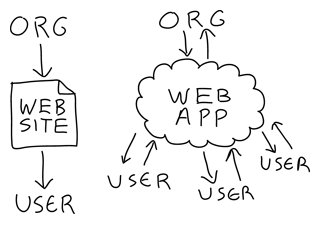We hear the term “Web app” thrown around a lot in tech circles. We hear about Web apps living in the cloud, mobile Web apps, and Web app development frameworks. However, I suspect that the average web user doesn’t know (and maybe doesn’t care) about the difference between a Web app and a website. Many people think that any URL you type into a browse takes you to a website, resulting in references to things like “that Facebook website.”
There is one key dividing line between a website and a Web app. A web site exists primarily to display information to the user, and a Web app exists primarily to facilitate the storing, sharing, and evaluation of user-supplied information.
dynamIt launches plenty of websites – from Charley’s Grilled Subs to the [Central Ohio Down Syndrome Society]((http://www.codss.org) to the Webby Award-winning Columbus College of Art and Design. These websites act as the official centralized source of information about the business or organization on the Internet. Interaction via a website is a one-way street; the website owner creates valuable and timely information that is then consumed by the website visitor.
Web apps are different in that users themselves bring the value to the application, using it to accomplish some goal. What would Gmail be if you never sent an email and no other email user ever sent one to you? What would Facebook be without your friends writing status updates, wall posts, event invitations, and bugging you to help them tend to their FarmVille? What would eBay be without anyone listing items for auction? These user-driven interactions have existed for decades in the form of online forums, instant messaging, and online shopping.

Some Web apps are even replacing popular desktop applications; Google Documents performs many of the same functions as the popular Microsoft Office suite of desktop applications. One of the biggest advantages of these “cloud-based” (based on the Internet rather than on the user’s local machine) Web apps is that they can be updated at any time by the application developers – and those changes are immediately reflected for every user of the Web app.
At dynamIt, I have spent many hours developing a privately used Web app for the Ohio Operating Engineers to track every aspect of their training process, from applications to interviews to training classes to on-the-job training to discipline. Several record keepers use this Web app full-time every day to track the progress of every trainee in the program as well as evaluate data about the program as a whole. Because this application is Web-based instead of being installed on each user’s local machine, every user has access to the same centralized database that immediately reflects the changes made in the system by every other user. The Web app can be accessed from any Internet-connected computer in the world, and when a bug in the application is discovered or a new feature is requested, the new version can be deployed directly to the server that hosts the application, providing an immediate update to every user without the need to install any updates on their local machines.
Our dynamIt programming framework is actually designed to be used for both website development AND Web app development. In fact, most of our clients choose to use our centralized Content Management System (a Web app built on our framework) to manage and publish content to their public-facing website! This united framework allows us to build custom Web apps that live alongside their parent websites, running on the same framework and performing tasks like event registration, donation processing, dynamic calendar interaction, member/donor management, and more with a look and feel that remains seamless from the parent website. This unity of user experience establishes and maintains the trust the user has in the parent organization by facilitating these interactions right on-site without passing them off to some third-party vendor that the user has no personal connection to.
While your website can (and should) provide a lot of valuable information to your site visitors, Web apps can make your business or organization more efficient by automating some of your core interactions with clients, customers, and target audiences. Take payments online, streamline back-and-forth communication, and enlist your site visitors to do data entry into your internal systems for you via strategic Web apps that meet your company or organization’s needs.
Use your website to talk to your site visitors, and use Web apps to interact with your site visitors.
As the everyday Web user gets more used to interacting with Web apps, how can your business or organization include this kind of direct user-centered interaction for the users of your website? Is there a Web app that could be included alongside your website that might make your interactions with them easier?